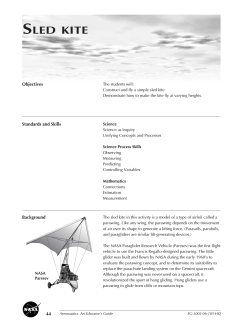
Let’s Go Fly a Kite Let's Go Fly A Kite
Let’s Go Fly a Kite Let's Go Fly A Kite With tuppence for paper and strings, you can have your own set of wings. With your feet on the ground, you're a bird in flight! With your fist holding tight, to the string of your kite! Let's go fly a kite Up to the highest height Let's go fly a kite And send it soaring Up through the atmosphere Up where the air is clear Oh, let's go fly a kite! When you send it flying up there, all at once your lighter than air! You can dance on the breeze, over 'ouses and trees! With your fist 'olding tight, to the string your kite! Let's go fly a kite Up to the highest height Let's go fly a kite And send it soaring Up through the atmosphere Up where the air is clear Oh, let's go fly a kite! From Mary Poppins. Written by Robert B. Sherman Kite Flying Safety Tips When flying a kite, it is good to remember the 3 C's of kite safety: Caution, Courtesy and Common Sense. STOP Child Labour Be aware of who or what is behind you as well as in front of you and avoid other kites, kite lines and kite fliers. Never fly a kite: ” near electric lines or poles. For the same reason do not fly in the rain or when it is stormy (the line can also carry electricity) ” with metal parts or lines which will attract electricity ” using fishing line or wire ” near the edge of a steep hill or slope or too close to an airport ” very close to or over roads where drivers could be distracted ” near ditches, stones, trees, If a kite gets caught in a tree or pole, leave it alone! Climbing high places can be very dangerous. and traffic or animals (e.g. nesting birds). STOP Child Labour school is the best place to work For more information about kites, check out: http://www.blueskylark.org http://www.nationalkitemonth.org/ http://www.first-school.ws/activities/occasions/kiteday.htm www.stopchildlabour.net • www.ilo.org • www.indianet.nl • www.mvfindia.in • www.antislavery.org The Stop Child Labour-School is the best place to work campaign is pleased to be cooperating with members of the Irish Task Group Against Child Labour-a civil society group consisting of NGOs and Unions. funded by the European Union How to Make your Kite www.stopchildlabour.net Fly a Kite to Stop Child Labour ‘Throw your dreams into space like a kite, and you do not know what it will bring back, a new life, a new friend, a new love, a new country’ Anais Nin Kite flying is popular in many countries around the world, unfortunately so is child labour. You can help raise awareness of child labour by making and flying kites to symbolise the setting free of the 218 million child labourers worldwide. Make your own Kites A kite consists of these basic parts: ” ” ” ” The Spine. The up-and-down, or vertical stick that you build your kite around. The Spar. The support stick(s) that are placed crossways or at a slant over the spine. Sometimes they are curved or bowed. The Frame. The joined spine and spars, usually with a string connecting their ends that form the shape of the kite and make a support for the cover. The Cover. The paper, plastic, or cloth that covers the frame to make a kite. ” ” ” ” The Bridle. One or more strings attached to the spine or spars, which help control the kite in the air. The Flying Line. The string running from the kites’ bridle, where you hold to fly the kite. The Tail. A long strip of paper or plastic of ribbon that helps to balance the kite in flight. Not all kites need tails. The Reel. The object you use to wind your flying line, to keep it form getting tangled or flying away. The Bumble Bee You will need for each kite: Fold and crease only half 0 recycled newspaper, tabloid size are the best); ” sewing thread. 3.5” 2.5” BA ” Sheet of paper (you can use Mark A and B You will need for each group: ” Stapler ” Hole punch. Now let's begin... 1. Fold the sheet of paper in half... 2. Mark two points, A and B on the folded edge of the paper. Point "A" should be 2.5 inches from the end, and point "B", 3.5 inches. 3. Fold the top corners of the page to point A and staple them in place. Do not crease the paper. Just bend it back. 4. Punch a hole at point B and attach your flying thread. 5. That's all!! Fold B Fold corners Staple and staple at point A Punch hole at B and tie line The Diamond Kite Materials: ” string ” sellotape tape or glue ” 1 sheet of strong paper (102cm x 102cm) ” 2 strong, straight wooden sticks of bamboo (you can get these in any hardward or gardening shops) ” markers, paint or crayons to decorate you kite. 1. Make a cross with the two sticks, with the shorter stick placed horizontally across the longer stick. Make sure that both sides of the cross piece is equal in width. Equal length 90 cm stick the string through the notch at one end of the cross-piece, and make another loop at the bottom. Stretch the string through the notch at one end of the loop at the bottom. Stretch the string through the notch at the other end of the cross-piece. Finish by wrapping the string a few times around the top of the stick and cutting off what you don't need. This string frame must be taut, but not so tight as to warp the sticks. 4. Lay the sail material flat and place the stick frame face down on top. Cut around it, leaving about 2-3cm for a margin. Fold these edges over the string frame and tape or glue it down so that the material is tight. Paper String 2. Tie the two sticks together with the string in such a way as to make sure that they are at right angles to each other. A good way to ensure that the joint is strong is to put a dab of glue to stick it in place. 3. Cut a notch at each end of both sticks. Make it deep enough for the type of string you are using to fit in to. Cut a piece of string long enough to String stretch all around the kite frame. Make a loop in the top notch and fasten it by wrapping the string around the stick. Stretch Back view of kite 5. Cut a piece of string about 122 cm long and tie one end to the loop at the other end of the string to the loop at the bottom. Tie another small loop in the string just above the intersection of the two cross pieces. This will be the kite's bridle, the string to which the flying line is attached. 6. Make a tail by tying a small ribbon roughly every 10cm along the length of string. Attach the tail to the loop at the bottom of the kite. 7. Decorate! The Newspaper Kite Materials: This kite has no rigid sticks used in its construction, instead you use rolled up newspaper, so if you have an old newspaper, a roll of sellotape and some scissors you have everything you need! 4. Roll some newspaper into a narrow tube shape. You will need 2 tubes. 1. Take 2 double pages of a Tabloid newspaper then tape them together. 5. Stick the tubes to the kite as shown in the photograph above. 2. Next measure 180 mm in from each corner and draw a line to join the points together. 3. Cut along this line to give you the outside shape of the kite. Reinforce the edges with sellotape. 6. Stick some string to the outer corners of the kite. That’s it!
© Copyright 2025





















